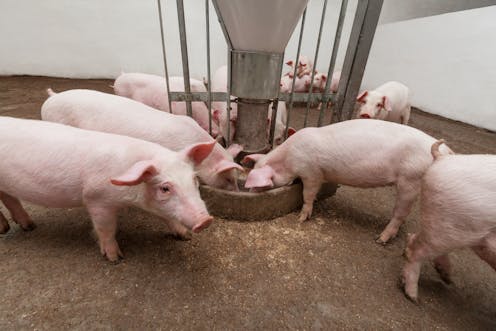
The rapid spread of antimicrobial resistance (AMR) around the globe represents a crisis on many fronts. Infections that are difficult, or impossible, to treat cause considerable public health and economic burdens, but also pose a serious threat to food security.
Undoubtedly, the imprudent administration of antibiotics has increased the evolutionary pressure for resistant strains of bacteria to emerge, but the problem goes much further than the irresponsible use of these drugs for human medicine.
Around one-third of all antibiotic usage in the UK is in farming – and globally this figure is much higher. Essentially, the same antibiotics are used to treat humans and animals, raising the fear that resistant strains of bacteria will evolve on farms, contaminate the wider environment, and ultimately spread to humans to spark serious outbreaks.
Alarm from health agencies, the scientific community, funding agencies and the media has led many research programmes to focus on the risk from antibiotic resistance in agricultural and environmental settings (so-called “one health” studies), alongside human-to-human transmission in hospitals or the wider community.
However, the extent to which antibiotic resistance in farms or rivers poses a risk to public health remains contentious because it’s very difficult to track how resistant strains (or genes) persist and move between different settings. A recent analysis noted “a clear lack of global empirical evidence for the transmission of AMR from the natural environment to humans”.
Fortunately, recent advances in genomic epidemiology, which accelerated during the COVID pandemic, provide the means to work out the transmission routes of bacteria and hence tackle this problem. The simple premise is that transmission between two sampling locations or hosts – say, individual humans, animals or environmental sources – will result in bacteria with essentially identical genome sequences in both samples.
Although this works well in hospitals, it is much harder to track in more complex settings that have many potential sources of infection. In a new paper, my colleagues and I describe a brute force approach to this problem. We sequenced nearly 3,500 genomes of Klebsiella bacteria, around half of which were the notorious AMR pathogen K. pneumoniae which can cause pneumonia, meningitis, urinary tract infections and infections in the bloodstream. We isolated these bacteria from 6,500 samples taken in under 18 months from a number of clinical, community, veterinary, agricultural, wild animal and environmental sources, all in and around the northern Italian city of Pavia.
The sampling approach is critical. By comparing bacteria collected over a short period, and in a defined region, the chances of detecting transmission taking place are increased. Also, strains of K. pnuemoniae that are resistant to carbapenems (an antibiotic of “last resort”, only used when all other antibiotics have failed) cause a major problem in the hospitals of this region, so the study also shed light on whether these resistant strains can survive outside hospitals.
Two clear conclusions
There were two clear conclusions to the study. First, there was no evidence of carbapenem-resistant strains outside hospitals, either from the genome data or by directly testing the bacteria. This shows there may be a cost to resistance that makes the bacteria unable to compete with other strains when antibiotics are not present. You can think of “cost” as being the bacteria having to wear full armour all the time when they’re not in battle.
Second, humans almost always catch these bacteria from other humans, rather than from animal or environmental sources. Similarly, cows mostly infect other cows, plants mostly infect other plants, and so on.
This does not mean that transmission between different hosts and settings never happens (there is a relatively high overlap of strains between dogs and humans, for example) but, on balance, other humans clearly pose the greatest infection risk.
Critically, even in those rare cases where humans have acquired bacteria from animals (zoonotic infections), there does not appear to have been onward transmission to other human hosts. In other words, there was no evidence of sustained outbreaks originating from non-human sources.
This study is reassuring from a public health perspective because it means that immediate public risks should be largely mitigated by standard hygiene measures, or avoiding activities with high risks of exposure, such as swimming in polluted water.
The results also tell us something important about the fundamental ecology of these bacteria. Barriers to the flow of bacteria from one host species to another, or between different environmental settings, point to rich and diverse ecological adaptations between different strains. Simply put, a strain that is adapted to a cow may temporarily be able to colonise a human, but it won’t last long in the face of human-adapted competitor strains.
Caveats
There are important caveats to this study. Even with extensive effort and resources, it is not possible to sample all possible sources of infection. For example, food is a likely source of bacteria that is not well represented in this study.
Also, while similar conclusions have been drawn for other species of bacteria in developed countries, including E. coli and Enterococcus faecium, the picture may be very different in developing countries where there is much closer contact between humans and animals, or where antibiotic usage is very high.
Finally, it would be reckless in the extreme to suggest that flooding the environment with antibiotics will have no long-term consequences for the spread of resistance. The emergence of new resistant bacterial strains might be a rare event in the environment (although it happens frequently in hospitals), but as the COVID pandemic demonstrated the “spillover” of newly emerged pathogens into humans can be devastating.
Although such events are far more commonly described for viruses than for antibiotic-resistant bacteria, it is critical that this threat, however existential or difficult to evaluate, continues to inform policy and regulatory guidelines.
Ed Feil receives funding from UKRI funding councils
This article was originally published on The Conversation. Read the original article.







